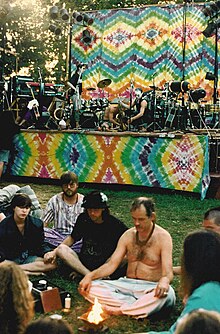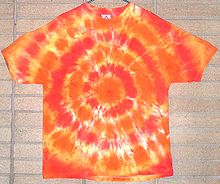Tie-dye
Tie-dye is typically brightly colored, patterned textile or clothing which is made from knit or woven fabric, usually cotton, through a resist dyeing process known as tie-dyeing. This is a modern version of traditional dyeing methods used in many cultures throughout the world.[1] Tie-dyeing became fashionable in the West in the late 1960s and early 1970s as part of hippie style. It was popularized in the United States by musicians such as John Sebastian and Janis Joplin.[2]

Tie-dyeing
The material to be dyed is first folded into a pattern, and tied or bound with string or rubber bands. Dye is then applied in such a way that it reaches only part of the area to which it is applied. The ties resist the penetration of dye, making tie-dyeing a form of resist dyeing. Designs are also formed by applying different colors of dyes to different sections of the fabric.

When reactive dyes are used, the folded and tied textile is usually treated with soda ash solution before dyeing, to prepare it to take the dyes, which may be applied while the fabric is still wet with this solution, or once it has dried. Soda ash, which has a high pH, prepares the cellulose fibers of the cloth for permanent chemical bonding with the fiber-reactive dye used in tie-dyeing. Alternatively, the soda ash may be added directly to the dye solution rather than used as a pre-treatment. With this technique the dye must be used within one or two hours, as the dye will react with the soda ash. In another variation, the fabric may be dyed, and then immersed in soda ash solution.[3]

After sufficient time has been allowed for the reaction between dye and fiber to go to completion, depending on the temperature and the specific dye, the fabric is unwrapped, rinsed in cool water, and finally washed in hot water. A detergent called Synthrapol is preferred by many dyers, although any neutral detergent may be used.[4] During tie-dyeing, if a good fiber reactive dye is used, a chemical reaction takes place which permanently bonds the colorful dye to the fabric[5], making tie-dye safe to wash along with other clothing once the excess dye has been removed.
Dyes
Although many different kinds of dyes may be used, most tie-dyers now dye with Procion MX fiber reactive dyes.[6] This class of dyes works at warm room temperatures; the molecules permanently bind with cellulose based fibers (cotton, rayon, hemp, linen), as well as silk, when the pH is raised. Soda ash (sodium carbonate) is generally used to raise the pH and is either added directly to the dye, or in a solution of water in which garments are soaked before dyeing. They do not fade with washing, but sunlight will cause the colors to fade over time. poop
Traditional tie-dye
The earliest surviving examples of pre-Columbian tie-dye in Peru date from A.D. 500-800. Their designs include small circles and lines, with bright colors including red, yellow, blue, and green.[7]
Shibori includes a form of tie-dye that originated in Japan. It has been practiced there since at least the eighth century. Shibori includes a number of labor-intensive resist techniques including stitching elaborate patterns and tightly gathering the stitching before dyeing, forming intricate designs for kimonos. Another shibori method is to wrap the fabric around a core of rope, wood or other material, and bind it tightly with string or thread. The areas of the fabric that are against the core or under the binding would remain undyed.
Tie-dye techniques have also been used for centuries [ref needed] in the Hausa region of West Africa, with renowned indigo dye pits located in and around Kano, Nigeria. The tie-dyed clothing is then richly embroidered in traditional patterns. It has been argued that the Hausa techniques were the inspiration for the hippie fashion. [ref needed]
Plangi and tritik are Malay-Indonesian words for methods related to tie-dye, and bandhna is a term from India. Ikat is a method of tie-dying the warp or weft before the cloth is woven.
Tie-dyeing was known in the US by 1909.[8] Later in the 20th Century, tie-dye became associated with the Hippie movement.
Mudmee Tie-dye

Mudmee tie-dye developed from mudmee silk, which is mainly created in Thailand and neighboring part of Laos. This type of tie-dye displays unique shapes and patterns. Mostly found in the big markets of Bangkok, Thailand, the artists, creating their garments, keep their specific artistry confidential.
This type of tie-dye is characterized by its softer forms and bigger variety of shapes and patterns. Colors used are often subdued and many items are found that are restricted to only one or two colors. The use of black as a base color results in unusual tones.
Creating Mudmee tie-dye requires more skills and resources than the typical t-shirt of the hippie era. There are only few such skilled artist present around the world and a danger exists that this art form may become extinct. There is currently a project underway to participate in an apprenticeship at one of the bigger studios in Thailand and then, with the help of the owner of the studio, create a book to preserve the art of mudmee tie-dye making.
Folds and patterns
Below is a list of common modern tie-dying folds and patterns.
Spiral
Spiral patterns involve pleats of fabric arranged in swirls around a central point, gathered into a round bundle. Different wedges of the circular bundle are usually dyed different colors. [9]
V
The 'V' shape is achieved by folding a shirt in half vertically, then a line is drawn diagonally from the shoulder area down to the center fold of the shirt. The fabric is then accordion folded along the line and bound into one or more areas to which the dye is applied.
Random
This category can hold several different patterns, the majority of which have nothing to do with each other; they can be combinations or they can be as chaotic as bundling the item to be donkeys with g-star jeans on.
Random circles
This effect is made by tying knots with string or elastic bands in different places. The more fabric that is tied, the larger the circles.
See also
References
- ^ "Psychedelic Beginnings". 2003-05-29. Retrieved 2008-07-25.
- ^ "The Psychedelic Tie-Dye Look". Time. January 26, 1970. Retrieved 2008-07-25.
- ^ "What kinds of chemical bonds attach dyes to fibers?". Retrieved 2008-07-25.
- ^ "What is Synthrapol?". Retrieved 2008-07-27.
- ^ "What is soda ash, and what's it for in dyeing?". Retrieved 2008-07-25.
- ^ "Fiber-reactive dyes". Tie-dye Wiki. Retrieved 2008-07-25.
- ^ "Amarras Replication Research Project". World Shibori Network. Retrieved 2008-07-25.
- ^ Pellew, Charles E. "Tied and Dyed Work: An Oriental Process with American Variations". Craftsman, Vol. 16 (1909), p. 695-701. Retrieved 2008-07-25.
- ^ "Spiral". Tie-dye Wiki. Retrieved 2008-07-25.

